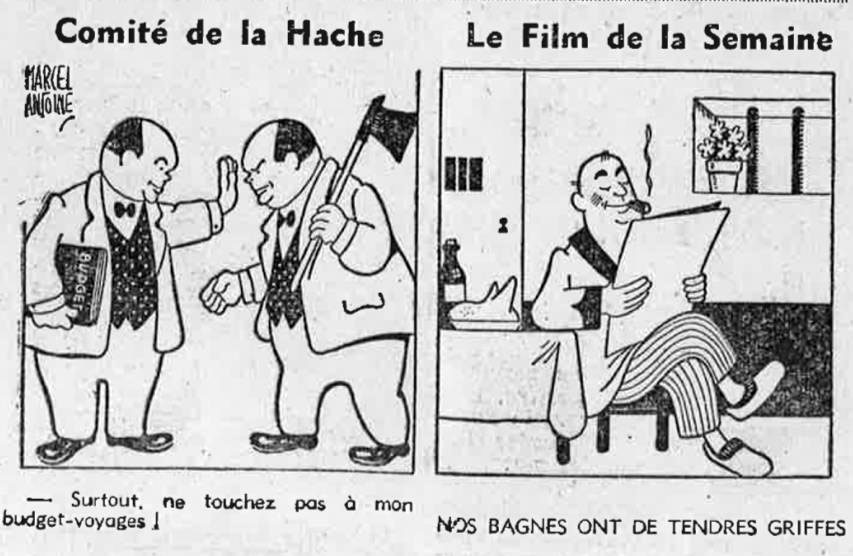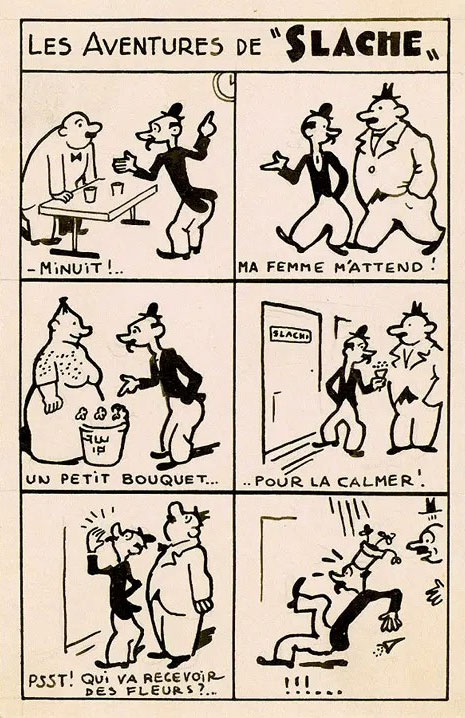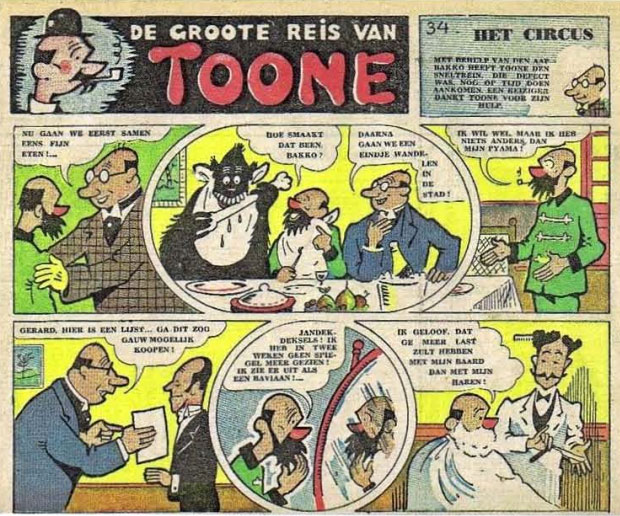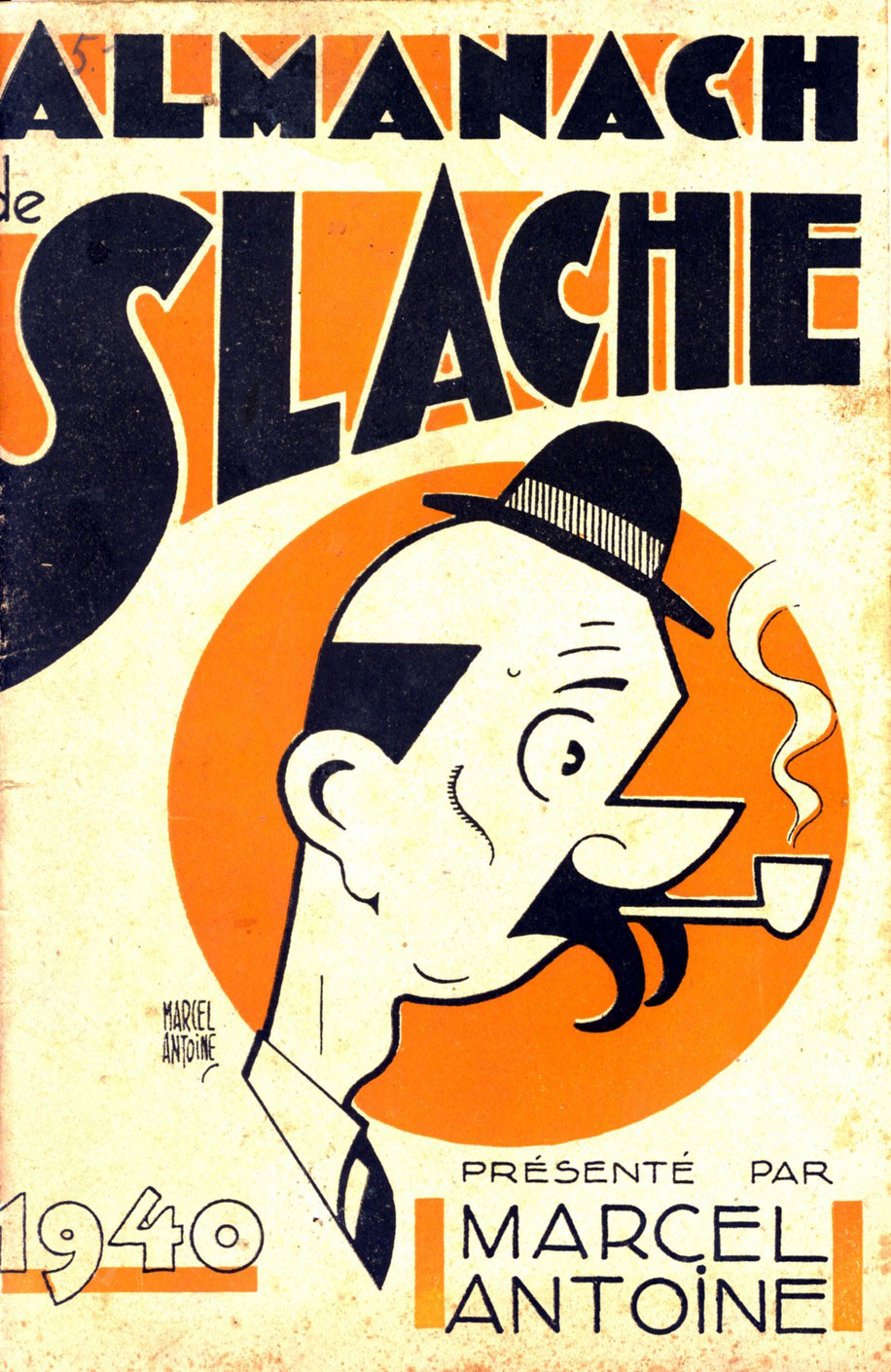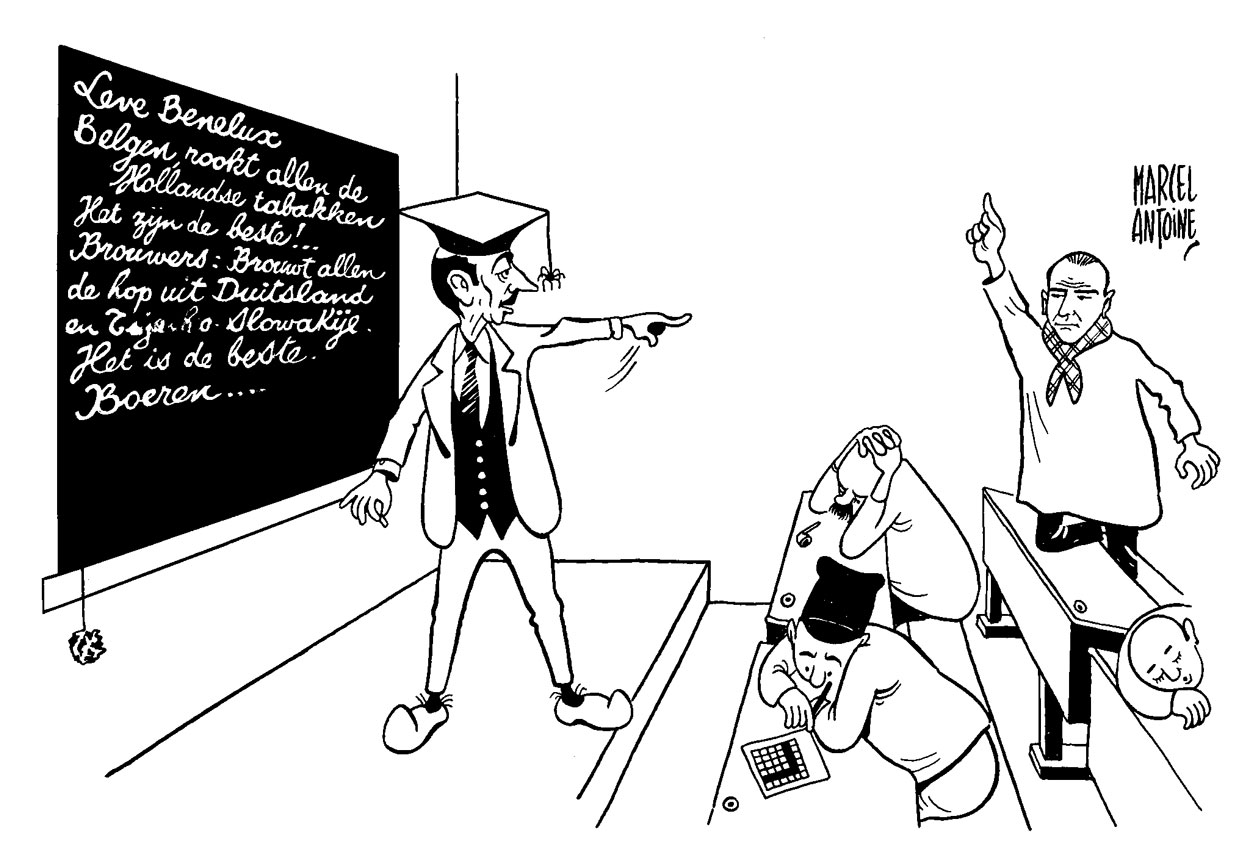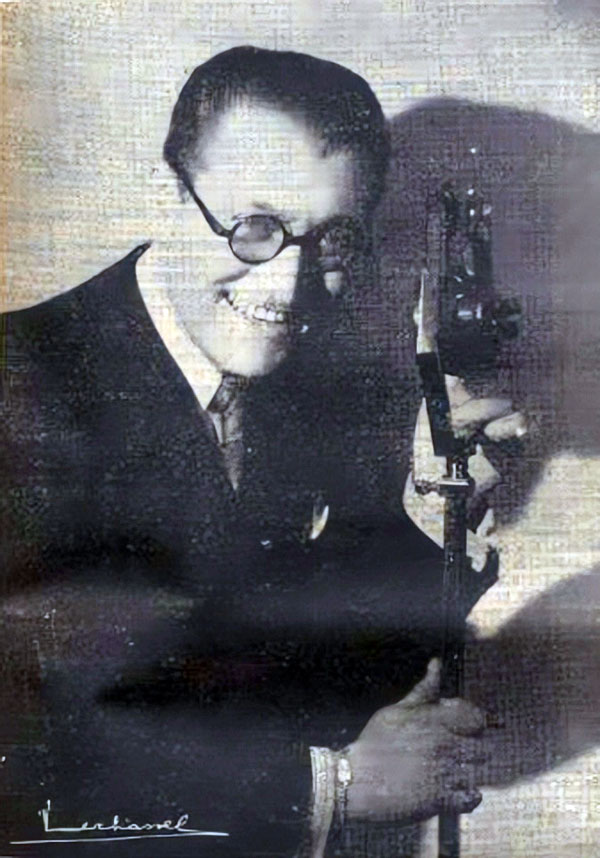'Le Grand Voyage de Slache' (Spirou #39, 26 September 1940).
Marcel Antoine was an early to mid-20th century Belgian cabaret artist, who performed comedy sketches in vaudeville theaters and on the radio. He was most recognizable in the guise of his comedy character Jules Slache. In addition, Antoine was active as a caricaturist and comic artist. He was house cartoonist for various publications, including Le Face à Main, L'Action Libérale, L'Action Wallonne, Le Soir, La Dernière Heure and Le Pays Libre, as well as co-founder of the long-running satirical weekly Pan. Between 1939 and 1941, Antoine wrote and drew a humorous adventure comic based on his Slache character, serialized in Spirou. This makes 'Slache' the oldest known celebrity comic in Belgian history. Antoine was also the founder of La Mine Souriante (1930), an association of humorous cartoonists.
Political cartoons for Le Face à Main (22 November 1947). The men in the first panel are caricatures of Belgian Prime Minister Paul Henri Spaak, planning to "axe his travel budgets".
Early years
Marcel Antoine was born in 1897 in Schaerbeek, a town just outside of Brussels, but grew up in the Ardennes. He took his secondary studies in Brussels. During the First World War, he was active as a cabaret comedian. His first drawings ran in L'Épatant and from 1927 on in Pourquoi Pas?, a satirical magazine for which he also wrote humorous rhymes. Antoine also made cartoons for the Brussels weekly Le Face à Main, where he had two columns, 'La Filme de la Semaine' and 'Un Mot de Slache'. In 1933, he produced two short series of comic strips, 'Les 36 Métiers de Patatje' ("The 36 Jobs of Patatje") and 'Les Aventures de Jack' for the Hainaut newspaper Le Populaire. Between 1933 and 1940, he was the regular artist of L'Action Wallone, in which he spoofed Walloon, national and international politics with his cartoons. Recurring themes in his work for this paper were the Belgian fascist movement Rex, an independent policy and Flemish-nationalist extremists.
He was also the author of the folkloric poems 'Scheele Mie!' (Éditions M. Lelong) and 'On A Eu Chaud!!' (Éditions J. Crémer), both published in Brussels.
La Mine Souriante
In 1930, Antoine established the group "La Mine Souriante" ("The Smiling Face"), a gathering place for local visual artists active in the humorous press. Among the early members were comedians like Léon Campion and Stanislas-André Steeman, but also cartoonists like Hergé, Jean Dratz, Jacques Ochs, Rali and Tenas. Over the course of fifty years, other notable artists joined, including the painters Georges Frederic, Philippe Swyncop and the Canneel brothers, as well as the comic creators and cartoonists Dino Attanasio, Fernand Cheneval, François Craenhals, Serge Creuz, Guy Depière, André Franquin, Louis Haché, Horn, Jean-Léo, Kari, Pierre Kroll, E.P. Jacobs, Morris, Peyo, Serdu, Jean Roba, Maurice Tillieux and Will. In 1930, La Mine Souriante first organized its annual Salon des Humoristes, which also held a cartooning contest each year.
Comic strip with the 'Slache' character. Translation: "Midnight! My wife is waiting! A little bouquet to calm her down. Psst! Who is going to receive the flowers?"
Slache
As a cabaret performer, Marcel Antoine was best-known for his comedy character Jules Slache. Slache is a stereotypical Brussels citizen, who speaks in juicy local slang. His last name was slang for a used slipper ("une slache"), with a double meaning that he was a henpecked husband, "kept under his wife's slipper." Slache is married to Toutouneke and has two good friends, Olive and Rigobert. Many Brussels citizens enjoyed Slache's farcical antics and recognizable language. Antoine became so associated with the role that he used it as his official pseudonym. For the Brussels weekly La Face à Main, Antoine made the column 'Un Mot de Slache', in which his Slache character commented on current events. On 25 September 1936, Antoine also brought his character to radio, playing over 250 comedy sketches on Radio Schaerbeek. Since Radio Schaerbeek was the most popular radio channel in the country at the time, the show 'Les Tribulations de Monsieur Slache et sa Femme Toutouneke' brought Slache to a wider audience.
'De Groote Reis van Toone'. Dutch-language version of 'Slache' from Robbedoes.
In 1939, Antoine also built a comic series around his Slache creations. In the 7 December 1939 issue of Spirou magazine (#49), 'Le Grand Voyage de Slache' began serialization. Historically, this would make 'Slache' the first of many Belgian comic strips based on a media celebrity. Earlier, Fernand Wicheler also occasionally gave his theatrical character Mr. Beulemans a role in his 'Le Dernier Film' (1921-1926) comic, but these were mainly cameos, while the feature generally consisted of self-contained gags. While Slache's original stage and radio incarnation relied on Brussels slang, the comic strip version used standard French. In Spirou's Dutch-language edition Robbedoes, 'Le Grand Voyage de Slache' ran under the title 'De Groote Reis van Toontje'. Given the fact that the protagonist received this different name, it seems likely that the fame of Slache was limited to the francophone community.
In 'Le Grand Voyage de Slache', Slache and his sidekick Olive try to retrieve an umbrella containing a precious stone. Their adventure leads them to a voyage all over the world. The stories and artwork are credited to Marcel Antoine himself. The adventures of Slache ran in Spirou until issue #8 of 1941 (20 February). In 1942, the Nazis banned Spirou, but after the Liberation, the magazine made its triumphant return. Between issue #1 (4 January 1945) and 10 (29 March 1945), Marcel Antoine returned to its pages, this time as the author of a column, 'Vie du Monde' ("Life of the World").
(Almanach de) Slache and other publications
In 1940, Antoine also launched a humorous magazine, Slache, presented as a spoof of an almanac, complete with parodies of horoscopes and advertisements. While Antoine provided most of the writing and illustrations, some of the drawings are credited to unknown artists like "Raymu" and "J. Cincia". It remains a mystery whether this was Antoine operating under pseudonyms, or two additional cartoonists. Other notable contributors for Almanach de Slache were the writers Jean Ray (John Flanders) and Léo Campion. Just like in his previous work for L'Action Wallone, Antoine used the Almanach de Lache to ridicule Nazism and the Belgian fascist party Rex. When the Nazis invaded Belgium in May 1940, the magazine was discontinued. It ran for only 15 issues.
In 1943, another 'Slache' book was published, 'Marcel Antoine Parle de Slache', with a foreword by Léo Campion and illustrations by the artist Lem (pseudonym of Jules Gustave Lempereur). The famous novelist and comic writer Jean Ray (AKA John Flanders) also contributed to this particular book. In 2004, the Belgian writer Georges Lebouc compiled a book about Marcel Antoine and his Slache creation, 'Slache' (Racine, 2004).
'Slache' comic strip from the 2 February 1940 issue of Slache.
World War II
During World War II, Antoine continued performing cabaret. After the war, most of these cabaret clubs disappeared. In the 16 July 1940 issue of La Nation Belge, he designed a medal depicting five theatrical stars of the Saint-Saveur Music-Hall. On 8 September 1945, Antoine and the newspapers La Dernière Heure and Le Soir organized a special "Victory Ball" ('La Bal de la Victoire') in Brussels to celebrate the first anniversary of the Allied Liberation of Brussels.
Cartoon for the 1954 Belgian elections. CVP/PSC Minister of Agriculture Charles Héger stands in front of the class and lectures his party colleague Georges Feryn, senator and farmer in Proven. The caption said: "CVP Minister-hop planter Héger teaches a lesson: Shut up, Feryn, and just sit down… You don't understand a thing about hops. Learn your lesson from Benelux. You know: for us the legs ["benen" in Dutch] and for them the Luxury…".
Post-war years and death
After the war, Marcel Antoine worked for the liberal newspaper Le Pays Libre, which circulated in the Liège region. During this period, Antoine's main themes were the defense of Wallonia, anticlericalism and human rights. He also made propaganda cartoons for the Belgian Liberal Party. Together with the songwriter Léo Campion and the cartoonist Jean-Léo (Jean-Léopold Rostagni), he founded the satirical weekly PAN in 1945, to which he contributed cartoons and served as an editor (1945-1948. He also drew the comics 'Les Aventures de Boby' in the newspaper Le Soir and 'Bill et Bull' in the children's magazine Bravo! (1947-1948).
Between 1949 and 1959, Antoine was the house cartoonist of the L'Action Libérale, the monthly magazine of the liberal arrondissement federation. At the 1958 World Exhibition in Brussels, Antoine made contributions to the humor-themed pavilion 'La Belgique Joyeuse'. A year later Antoine established another magazine, Cancan, but its publication was very short-lived due to his death in April 1959. Marcel Antoine passed away in Liège at age 62.
Marcel Antoine (Le Radio, 1938).




